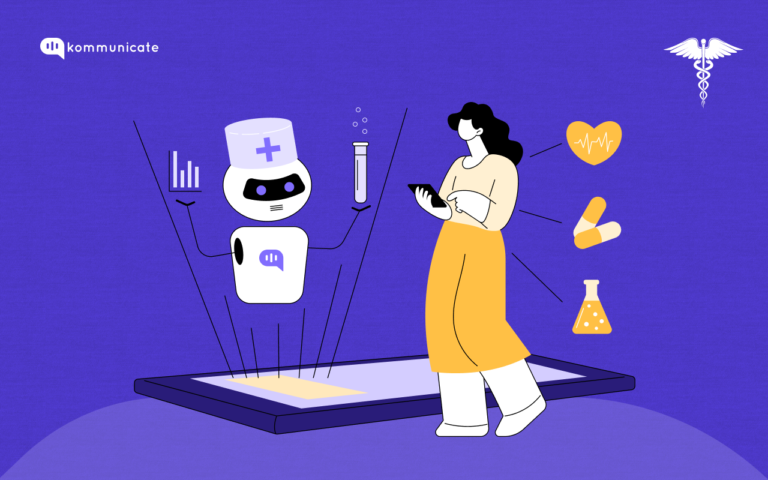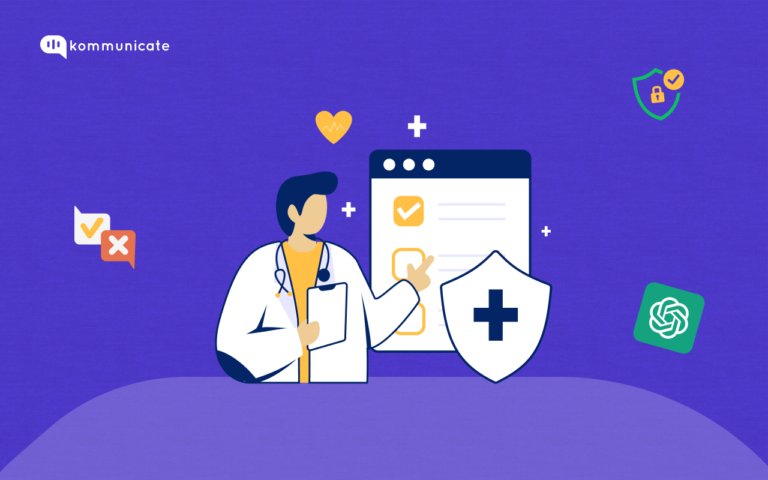Updated on January 18, 2024

Let’s begin with getting a basic understanding about a Hospital Management System (HMS).
“A hospital management system (HMS) can be defined as an integrated software that handles different aspects of clinic workflows, such as administrative, medical, legal, and financial.”
It is a wise investment for healthcare organizations as it can drastically improve the quality of patient care and the efficiency of healthcare services.
In fact, an HMS can help meet specific objectives and attain goals such as:
- Improving patient experience by creating a convenient and seamless patient experience
- Reducing the workload and stress of managing paperwork by streamlining workflows
- Preventing or minimizing errors such as misdiagnosis, medication errors, billing errors, etc.
- Enhancing quality of patient care by facilitating collaboration and consultation with other specialists or departments.
- Increasing revenue as a result of all the above efficiencies
In this blog post, we will provide a comprehensive guide on how to choose, implement, and use an HMS effectively for your hospital. We will also cover the main components or modules of an HMS. This includes appointment management, patient record management, staff management, billing and insurance, inventory management, etc.

From Chaos To Order: The Many Benefits Of Using A Hospital Management System
From a bird’s eye view, an HMS system helps bring order to chaos in running a healthcare organization. Although the bigger benefits accrue to the organization, at a ground level, each stakeholder group forming part of the organization stands to benefit individually and collectively from the system.
Let’s understand the benefits better with a stakeholder-based analysis.
Benefits that an HMS system can provide to patients
An HMS can provide a convenient and seamless experience for booking appointments, accessing medical records, paying bills, receiving reminders and notifications, etc. It can also improve the quality and safety of care by reducing errors, delays, and complications. An HMS can also enhance patient satisfaction and loyalty by providing personalized and customized services, such as online consultations, feedback surveys, loyalty programs, etc.
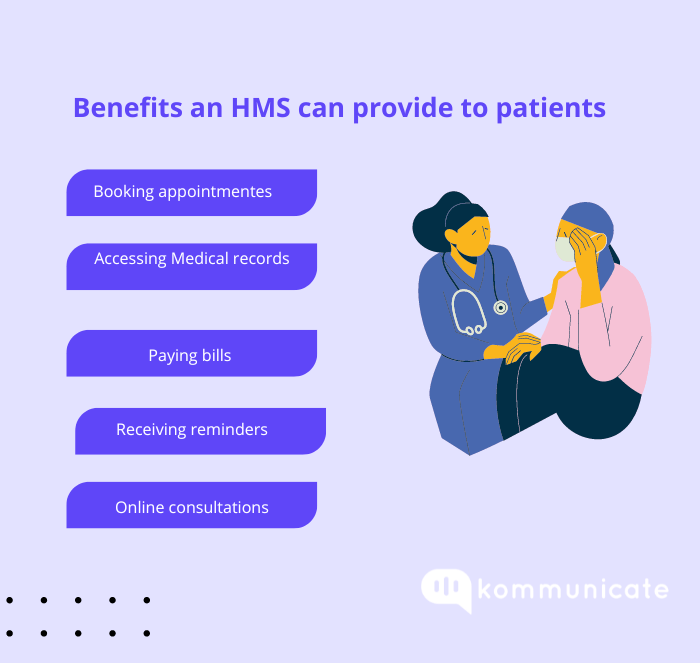
Benefits that an HMS system can provide to healthcare providers
An HMS can reduce the workload and stress of managing paperwork, data entry, communication, coordination, etc. It can also improve the accuracy and quality of data and information by eliminating duplication, inconsistency, and incompleteness. An HMS can also facilitate collaboration and cooperation among healthcare providers by enabling information sharing, consultation, referral, etc.
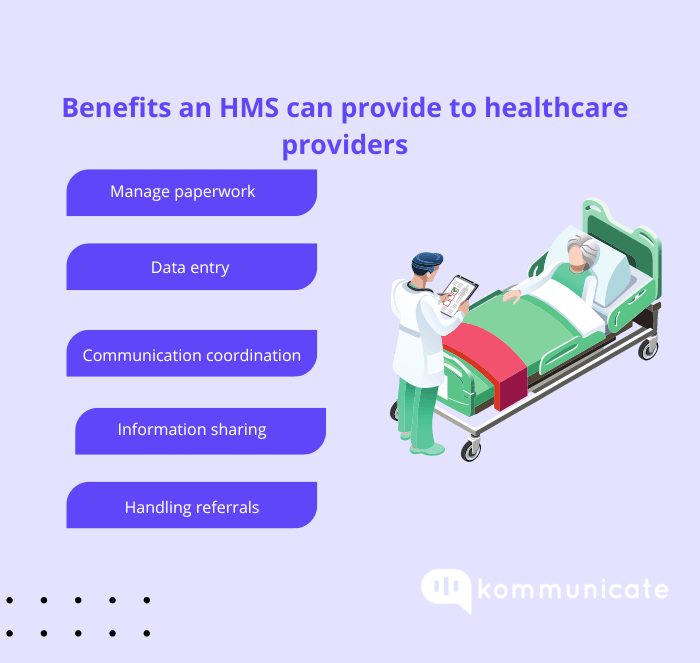
Benefits that an HMS system can provide to doctors
An HMS can enhance the clinical decision- making and diagnosis process by providing easy access to patient history, test results, prescriptions, etc. It can also facilitate collaboration and consultation with other specialists or departments by enabling video conferencing, telemedicine, etc. An HMS can also improve the efficiency and productivity of doctors by automating tasks such as scheduling, billing, reporting, etc.
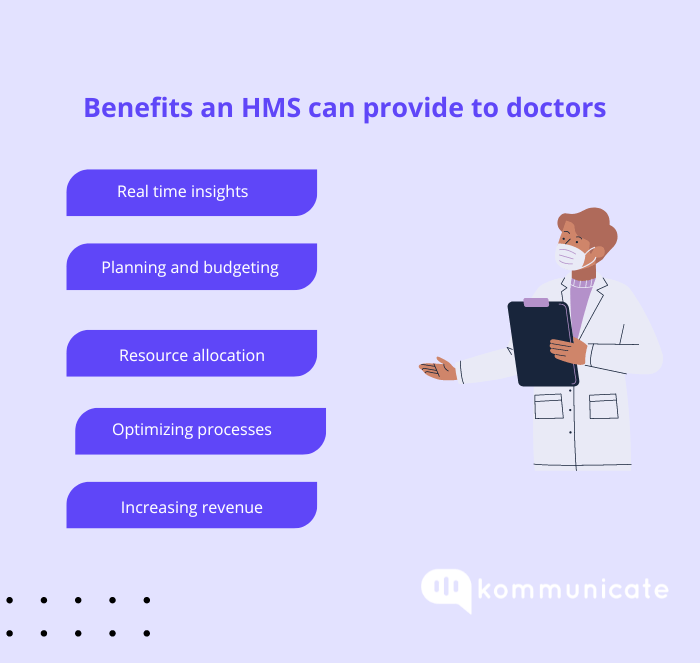
Benefits that an HMS system can provide to hospital administrators or management
An HMS can provide real-time insights and reports on the performance and outcomes of the hospital. It can also help in planning and budgeting, resource allocation, quality improvement, risk management, etc. An HMS can also increase the profitability and competitiveness of the hospital by optimizing processes, reducing costs, increasing revenue, attracting and retaining customers, etc.
Of course, all these stakeholders will not be using all the components or modules of an HMS. They use specific components or modules that make day-to-day responsibilities easy to execute.
Let’s dive into the major components and modules that make up a hospital management system.
The Essential components that make up a Hospital Management System
In an HMS, each component or module performs specific functions and tasks related to the hospital operations. Some of the common components or modules are:
1. Appointment Management
Every hospital needs a convenient and hassle-free process of providing appointments to patients. The appointment management module enables patients to book, modify, or cancel appointments online. It follows a logical process to match the patient’s illness to the doctor’s expertise. This helps in providing convenience and flexibility to the patients in availing, and the doctors by reducing no-shows and optimizing their schedules.
2. Patient Record Management
The function of this component is to store and manage all patient-related information, like medical history, diagnosis, treatment, medication, etc., in a structured and organized fashion. The module serves both the patients and the doctors with easy access to historical medical information that could give insights about the next steps in improving the patient’s health or dealing with their ailments.
3. Clinical Workflow
Every software needs to follow a specific workflow, right from creation until approval and archival, to ensure consistency. The clinical workflow component helps design the entire patient-hospital relationship by detailing the clinical processes and procedures that take place in the hospital.
This includes recording admission, discharge, transfer, referral, etc. or providing alerts and reminders for critical events or actions.
4. Staff Management
This component manages all the information related to the staff’s qualifications, roles, responsibilities, schedules, payroll, etc. It also facilitates communication and coordination among staff members. This component benefits the staff by reducing their workload and stress and the hospital administrators or management by improving staff efficiency and productivity.
5. Billing and Insurance
This component generates bills and invoices for the services provided by the hospital. It also handles insurance claims and reimbursements. This component benefits the patients by providing transparent and accurate billing information and the hospital administrators or management by increasing revenue and reducing costs.
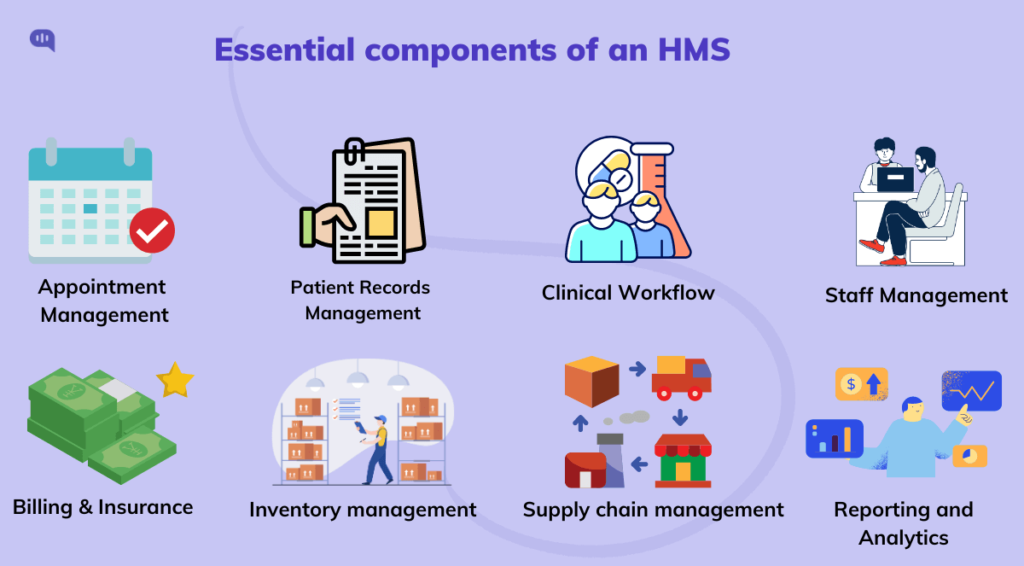
6. Inventory Management
This component tracks and manages the inventory of medical equipment, supplies, drugs, etc. It also ensures optimal utilization and availability of resources. This component benefits the healthcare providers by providing them with the necessary resources for their work and the hospital administrators or management by reducing wastage and losses.
7. Supply Chain Management
This component manages the procurement, distribution, storage, and disposal of medical materials and goods. It also coordinates with suppliers, vendors, distributors, etc. This component benefits the healthcare providers by ensuring timely and quality delivery of supplies and the hospital administrators or management by optimizing supply chain performance and reducing risks.
8. Financial Management
This component handles the financial transactions and records of the hospital. It also provides financial analysis and reporting. This component benefits hospital administrators or management by providing them with financial insights and guidance for decision-making and planning.
9. Reporting and Analytics
This component provides various reports and dashboards on the performance and outcomes of the hospital. It also provides data visualization and analytics tools for data exploration and discovery. This component benefits the hospital administrators or management by providing them with actionable information and intelligence for quality improvement and strategic development.
Factors to Consider While Choosing a Hospital Management System
Choosing or building an HMS is a crucial decision for your hospital, as it can affect the quality and efficiency of your healthcare services. It is also indirectly related to the satisfaction and loyalty of your patients and staff. Therefore, you should consider all possible factors before selecting or developing an HMS that suits your needs and goals, such as:
1. Must be rich in features/Capabilities
The HMS should have all the features and functions that you require for your hospital operations. You should identify your current and future needs, gaps, and opportunities and evaluate the available options and solutions in the market. You should also consider the compatibility and integration of the HMS with your existing systems and devices, including healthcare security systems, employee communications platforms and building management tools.
2. It should be user-friendly
The HMS should be easy to use and navigate for both staff and patients. It should have a user-friendly interface and design, as well as clear and simple instructions and guidance. It should also provide training and support materials for the users to learn and master the HMS. Ideally, the learning curve should not be steep so that any user can easily master the system and start using it effectively.
3. Must be easily scalable
The HMS should be able to accommodate the growth and expansion of your hospital. The HMS should be able to handle the increasing volume and complexity of data and transactions, as well as the changing needs and expectations of your customers and stakeholders. It should also be flexible and adaptable to new technologies and innovations.

4. It should have maximum uptime
The HMS should be able to perform consistently and accurately without errors or glitches. More brownie points if it can provide maximum uptime with minimal downtime for maintenance or outages. In case of downtime, the system vendor should be able to implement the recovery process and restore system access immediately. Last, but not the least, it should also have a backup and disaster recovery system in case of any failure or disaster.
5. Should be high on security
Patient healthcare data is the most sensitive data there is. The HMS should be able to protect patient data and admin information about your hospital from all imaginable unauthorized access or breach. Further, it should be compliant with all applicable relevant laws and regulations regarding user data privacy and security, such as HIPAA, GDPR, etc. As an additional layer of security, the HMS must have encryption, authentication, authorization, and auditing mechanisms to ensure data security and integrity.
6. It should be affordable
The HMS should be affordable and within your budget. Further, the pricing structure and payment terms should be transparent and predictable. If you’re to get positive ROI from implementing the HMS, it should also be low maintenance, implying requiring minimal hardware investment or maintenance. The ideal choice would be a cloud-based HMS.
These are some of the factors to consider while choosing or building an HMS for your hospital. By considering these factors, you can select or develop an HMS that meets your requirements and expectations, as well as enhances your performance and outcomes.
Challenges Faced While Implementing an HMS
Implementing an HMS in your hospital is not an easy task, as it involves various technical, organizational, and human factors.
Some of the challenges that you may face while implementing an HMS are:
1. Confronting technical issues
You may encounter technical issues, such as software bugs, hardware failures, network problems, compatibility issues, etc., while implementing an HMS. These issues may affect the functionality and performance of the HMS, as well as cause delays and disruptions in your hospital operations.
Remedy to overcome this challenge:
Enlist a reliable and experienced vendor or developer who can pitch in to fix glitches on a real-time basis. You may also consider engaging them on Annual Maintenance Contract (AMC) to provide timely and quality technical support and maintenance.
2. Overcoming stakeholder resistance to change
You may face staff members’ resistance to change while implementing an HMS. It is natural for some staff members to show reluctance or unwillingness to adopt the new system. They could cite several reasons such as lack of awareness, lack of training, lack of trust, fear of losing their jobs, etc. The good news is, this is a common challenge not only with HMS implementation, but with all forms of software implementation.
Remedy to overcome this challenge:
Communicate and engage with your staff members throughout the implementation process. You should also provide them with adequate training and support on how to use the HMS effectively. You should also address their concerns and feedback, and highlight the benefits and value of the HMS for them.
3. Managing change and transition
You may face change and transition challenges while implementing an HMS. It calls for an extensive requirement of your existing workflows, approval processes, org policies, user roles, privileges, etc. to align with the new system.
Remedy to overcome this challenge:
To manage this change and transition smoothly, you should have a clear and realistic plan and timeline for the implementation project. You should also have a dedicated and competent team who can lead and manage the project effectively. You should also monitor and evaluate the progress and outcomes of the project regularly.
These are some of the challenges that you may face while implementing an HMS in your hospital and the remedies that can provide some respite. By anticipating and addressing these challenges proactively, you can implement an HMS successfully and efficiently.
How to Implement an HMS in Your Hospital
Implementing an HMS in your hospital is a complex and challenging project. If you follow these six broad steps to implementing a Hospital Management System, it could be easier.
- Planning
- Analysis
- Design
- Development
- Deployment
- Evaluation
1. Planning
The first step is where you define the scope, objectives, timeline, budget, and roles of the implementation project. You should also identify the stakeholders, risks, challenges, and expectations of the project.
2. Analysis
Once the planning is done, analyze the current situation – point zero and make an inventory of the needs, gaps, and opportunities of your hospital. You should also evaluate the available options, solutions, and vendors for the HMS. Once this is done, conduct a feasibility study and a cost-benefit analysis of implementing the HMS.
3. Design
Assuming the cost-benefit analysis turns out to be positive, proceed to design the architecture, configuration, customization, integration, and testing of the HMS. Prepare the technical documentation and user training materials for the HMS during the same stage.
4. Development
Ensure that the development proceeds in tandem with the design specifications. Perform quality assurance and testing periodically to ensure the functionality and performance of the HMS. You should also resolve any technical issues or problems that may arise during the development process and before proceeding to the deployment phase.
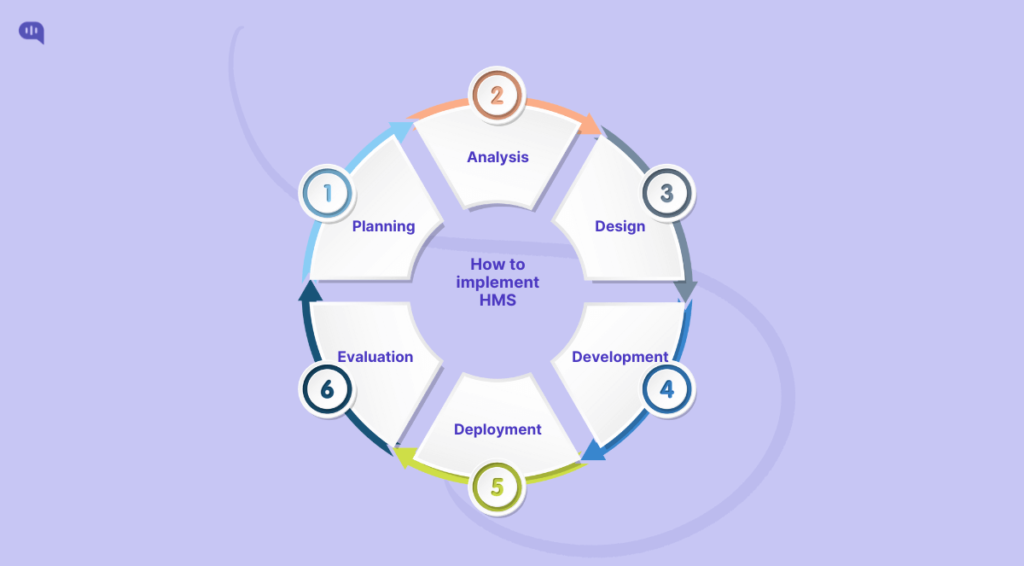
5. Deployment
Do a test launch of the HMS in your hospital. Choose a plot group to use the system before rolling it out as an org-wide compatible system. Further, to ease change management, you should also provide training and support to your staff and customers on how to use the HMS effectively. You should also communicate and engage with your stakeholders throughout the deployment process to ensure their satisfaction and loyalty.
6. Evaluation
Even with all planning, testing and deployment, some errors are bound to slip through the cracks. To continuously improve the system, evaluate the outcomes and impacts of the HMS on your hospital operations. You should also monitor and measure the key performance indicators (KPIs) and feedback of the HMS.
Best Practices in Using an HMS
Using an HMS can improve the quality and efficiency of your healthcare services, as well as the satisfaction and loyalty of your patients and staff. However, to use an HMS effectively, you should follow some best practices that can help you optimize your workflows, processes, and resources.
Some of the best practices are:
1. Update and maintain the latest data
For any system, especially for HMS, data is the crux of all operations. Maintaining accurate and updated information is necessary for proactive decision-making about patient care. It will also prevent or minimize errors, inconsistencies, and incompleteness in your data and information. You should also backup your data and information periodically to avoid data loss or corruption.
2. Train users to use the HMS fully and efficiently
This will help you optimize your workflows, processes, and resources for better results and outcomes. You should also explore and learn the new features and functions that the HMS may offer from time to time. You should also customize and configure the HMS according to your specific needs and preferences.
3. Make the HMS the single source of truth
Inculcate the organizational culture to communicate and coordinate with your staff, patients, vendors, and other stakeholders only through the HMS.You should also provide feedback and suggestions to the HMS vendor or developer to improve the performance and quality of the HMS. This will ensure that the HMS becomes the single source of truth regarding every information pertaining to the hospital.
4. Review the HMS performance from time to time
This will help you identify and resolve any issues or problems with the HMS. It will also help you explore and implement any enhancements or innovations for the HMS. You should also benchmark your performance and outcomes against your goals and objectives, as well as industry standards and best practices.
Hospital Management System – In A Capsule
Every business needs an ERP software to manage its diverse business functions. For a hospital, it takes the form of a HMS. a HMS system helps bring all hospital functions, processes, and data into a single system. It breaks down org silos and helps patients, healthcare providers, doctors, nurses, and the admin team to have a holistic view of their individual pieces of the bigger transaction.
Implementing a HMS can deliver great benefits to all stakeholders involved, mainly patients, doctors, admin teams, and even external vendors. However, to get the implementation right, you must follow a specific process. We have outlined the broad steps in the previous sections.
Similarly, to reap maximum ROI out of the HMS investment, you must also invest in user training and follow the recommended best practices. All these would help your hospital deliver superior patient care and also improve its profitability.
As the Head of Growth, Marketing & Sales, Yogesh is a dynamic and results-driven leader with over 10+ years of experience in strategic marketing, sales, and business development.
At Kommunicate, we envision a world-beating customer support solution to empower the new era of customer support. We would love to have you on board to have a first-hand experience of Kommunicate. You can signup here and start delighting your customers right away.



